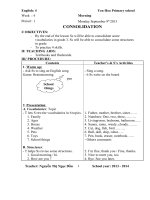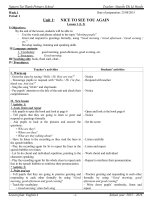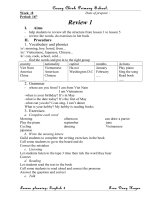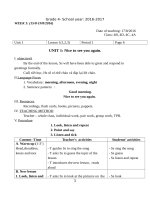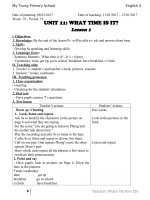Giáo án Tiếng Anh 4
Bạn đang xem bản rút gọn của tài liệu. Xem và tải ngay bản đầy đủ của tài liệu tại đây (149.11 KB, 10 trang )
Date of preparing: 14/12/2017
Week 16
Period 61
UNIT 10: WHERE WERE YOU YESTERDAY?
Lesson 1: 3-4-5
I. Objectives:
1. Knowledge:
By the end of this lesson, Ps will be able to : listen to and write specific information
about where someone was in the past
- Sentence patterns: revision
- Vocabulary: revision
2. Skills: Listening-reading-speaking-writing.
3. Attitude: Educate Sts to love their lesson.
Work hard
III. TEACHING AIDS:
1. Teacher’s: student’s and teacher’s book, pictures, cassette.
2. Students’: books, notebooks, workbooks.
II. TEACHING METHODS:
- Work in pairs , individual, in groups ….
IV. PROCEDURE:
1. Class organization:
- Greeting: Good morning/ Good afternoon. How are you?
- Checking for the students’ attendence:
Class
Date of teaching
Absent Students
4C
19/12/2017
2. Warm up :6’
Spend a few minutes revising the previous lesson. Call a few pairs to the front of the
class to ask and answer the question
3. New lesson
Teacher’s and students’ activities
Content
* Activity 1: (9’)
3. Listen and tick.
3. Listen and tick.
Key: 1- c 2 – b 3 – a
a. Pre-listening:
- T looks at the books and sets the scence:
How many numbers are there?
How many pictures are there?
- Ask Ps to look at the pictures on page 65
- Tell Ps that they are going to listen to the three dialogues
about where characters were and tick the correct pictures.
- Have them look at the pictures to identify the similarities
and differences.( 1a. Tom was in the cinema. 1b. He was
in the swimming pool, 1c. He was at school. 2a: Linda
was at the zoo, 2b: Linda was in the library, 2c: She was
in the cimema, 3a: Tony was on the beach, 3b: He was in
the library, 3c: He was in the garden. Check
understanding
b. While-listening:
- Play the recording more than once, if necessary. Ask ps
to listen to the recording and tick the correct pictures. Tell
them to focus on the subjects.
- Play the recording again for them to check their
answers.
- Get Ps to swap their answers before you check as a
class.
Key: 1- c 2 – b 3 – a
c. Post listening:
- Role-play
* Activity 2: (10’)
a. Pre- writing:
- Ask ss to look at the pictures on page 65.
- Tell Ps that they are going to complete the sentences
about where the character were.
- Have they look at the pictures to identify the what
someone is doing.. Ask them what these activities are
called in English. Check understanding.
- Ask ps to find approprivate words to complete the
sentence under each picture.
b. While- writing:
- Give them time to do the task independently. Go around
offering help, if necessary.
- Get them to swap their answers before checking as a
class. If there is enough time, call some ps to read aloud
the complete sentences.
Key:
1. at home/ in the kitche.
2. in the library/ at school..
3. on the beach.
c. Post reading:
*Activity 3:7’
Tell ss that they are going to sing the song Where were
you yesterday? . Teach the song, following the produre in
teaching the unit components in Introduction.
- Have them read each line of the lyrics aloud. Check
comprehension.
- Play the recording all the way through. Ask ss to do
4. Look and write
Key:
1. at home/ in the kitche.
2. in the library/ at school..
3. on the beach.
c. Post reading:
5. Let’s sing
choral and individual repetition of the song line by line
until they get familiarized with the pronunciation, the
stress, the rhythm and the tune of the song.
- Play the recording again and get Ps to sing along with
the recording.
- Divide the class into two groupss, one sings the song
and the other do t.he actions.
4. Consolidation: (3’)
What’s the content of the lesson? Or What have you learnt today?
5. Homelink: (3’)
Do exercises in the workbook. Learn by heart the new words and structures.
6. Comments:
……………………………………………………………………………………………
……………………………………………………………………………………………
……………………………………………………………………………………………
Period 62
UNIT 10: WHERE WERE YOU YESTERDAY?
Lesson 2: 1-2-3
I. Objectives:
1. Knowledge: By the end of this lesson, Ps will be able to ask and answer questions
about where someone did in the past, using what did you do yesterday? I……
- Sentence patterns: What did you do yesterday?
I played badminton
- Vocabulary: played badminton, painted a picture, watered the flowers
2. Skills:
- Develop Ss Listening-reading-speaking-writing.
3. Attitude: Educate Sts to love their lesson.
Work hard
III. TEACHING AIDS:
1. Teacher’s: student’s and teacher’s book, pictures, cassette.
2. Students’: books, notebooks, workbooks.
II. TEACHING METHODS:
- Work in pairs , individual, in groups ….
IV. PROCEDURE:
1. Class organization:
- Greeting: Good morning/ Good afternoon. How are you?
- Checking for the students’ attendence:
Class
Date of teaching
Absent Students
4C
19/12/2017
2. Warm up :6’
Spend a few minutes revising the previous lesson by having the class sing a song What
day is it today?
3. New lesson
Teacher’s and students’ activities
* Activity 1: (8’)
- T tell ps that they are going to read a story where
Ps ask and answer questions about what they did in
the past.
- Ask Ps to open their book on page 66 and look at
the pictures.
- Have them look at the four pictures to identify the
characters and understand the context in which the
language is used. Ask them questions such as: Who
are they? Where are they? What are they saying?
( a: Tony asks Mai where she was yesterday and she
answers she was at home. b, c and d, Tony asks
what Mai did, using What did you do in the
morning/ afternoon? And What about yesterday
evening?Check understanding.
- Play the recording more than once, if necessary,
for ss to listen and repeat. Do choral and
individually repetition, pointing to the characters
speaking.
- Play the recording again for Ps to listen and repeat.
* Activity 2: (10’)
2. Point and say.
a. Vocabulary:
Content
1. Look, listen and repeat
2. Point and say.
a. Vocabulary:
- Teach the phrases: played
- Teach the phrases: played badminton, painted a
badminton, painted a picture,
picture, watered the flowers. Check comprehension. watered the flowers. Check
b. Model sentences:
comprehension.
A: What did you do yesterday?
b. Model sentences:
B: I played badminton
A: What did you do yesterday?
- Concept check: intonation, using
B: I played badminton
c. Practice:
- Tell Ps that they are going to practise asking and
answering questions about what someone did in the
past.
- Let them look at the bubbles to understand how to
ask and answer questions about what someone did
in the past, using what did you do yesterday? I
+verb- ed……
- Ask ps to identify what the Ps did yesterday. Point to the first picture and model the task with one
pupil, using the sentences in the bubbles and the
phrase under the picture( teacher: What did you do
yesterday ? Pupil: I played badminton.). Repeat the
procedure with the other rows in the table.
- Ask Ps to practise in pairs, one asking the question
and the other giving the answer, using the prompt in
the bubbles and pictures.
- Select some pairs to demonstrate the task in front
of the class. Monitor the activity and other help, if
necessary.
*Language note: In this lesson: verb-ed is used to
expressed an action that happened in the past.
Expressions for the past time include yesterday,
yesterday morning( afternoon, evening) , last night,
last (week,month,year)
* Activity 3: 5’
3. Let’s talk.
- Tell Ps that they are going to revise what they have
learnt in L1 and 2, using: Where were you
yesterday? And What did you do ?
Get them to
work in pairs and ask and answer the three questions
- Call a few pairs to act out their conversation.
- Encourage ps to observe and give comments in
English.
4. Consolidation: (3’)
What’s the content of the lesson? Or What have you learnt today?
5. Homelink: (3’)
Do exercises in the workbook. Learn by heart the new words and structures.
6. Comments:
……………………………………………………………………………………………
……………………………………………………………………………………………
……………………………………………………………………………………………
Period 63
UNIT 10: WHERE WERE YOU YESTERDAY?
Lesson 2: 4-5-6
I. Objectives:
1. Knowledge: By the end of this lesson, Ps will be able to listen specific information
and write about what someone did in the past.
- Sentence patterns: revision
- Vocabulary: revision
2. Skills:
- Develop Ss reading, writing and listening skills
3. Attitude: Educate Sts to love their lesson.
Work hard
III. TEACHING AIDS:
1. Teacher’s: student’s and teacher’s book, pictures, cassette.
2. Students’: books, notebooks, workbooks.
II. TEACHING METHODS:
- Work in pairs , individual, in groups ….
IV. PROCEDURE:
1. Class organization:
- Greeting: Good morning/ Good afternoon. How are you?
- Checking for the students’ attendence:
Class
Date of teaching
Absent Students
4C
20/12/2017
2. Warm up :5’
Spend a few minutes revising the previous lesson by Charades . Follow the procedure in
Games in Introduction. Ask Ps to mime what they did yesterday( eg: watched TV, played
badminton, watered the flowers, painted a picture)
3. New lesson
Teacher’s and students’ activities
Content
* Activity 1: (11’)
4. Listen and number.
a. Pre-listening:
Key: a - 3 b- 1 c- 2
- T looks at the books and sets the scence:
How many pictures are there?
- Ask Ps to look at the pictures on page 67
- Tel Ps that they are going to listen to the four dialogues
about where Linda was and what she did, and number the
correct pictures.(a Linda played volleyball on the beach,
b: She watered the flowers at home, c: She painted a
picture at school). Check understanding.
b. While-listening:
- Play the recording for ss to number the pictures.
- Play the recording again for them to check their
answers.
- Get Ps to swap their answers before you check as a
class.
Key: a - 3 b- 1 c- 2
c. Post listening:
- Have Ps play the game: Lucky numbers.
* Activity 2: (9’)
5. Look and write
. Pre- writing:
Key:
- Ask ss to look at the pictures on page 67.
1. in the garden, watered
- Tell Ps that they are going to complete the the answers the flowers.
to the questions about where the characters were and what 2. in the bedroom, watched
they did, using the picture cues.
tv.
- Ask them to look at the three pictures to identify where 3. on the beach, played
the characters were and what they did. Then ask Ps to football.
read the incomplete answers and find appropriate words
to fill the gaps.
- Give them a few second to look at the timetable and read
the text. Then check comprehension by asking When does
the ps have E?
b. While- writing:
- Set a time limit for the task and offer help, if necessary.
- Check the answers as a class and call one or two ps to
read aloud the completed text.
Key:
1. in the garden, watered the flowers.
2. in the bedroom, watched tv.
3. on the beach, played football.
c. Post writing:
- Ask Ps to read the answers .
* Activity 3: (6’)
6. Let’s play: Pelmanism
Pelmanism
- Tell Ps that they are going to play the game Pelmanism.
Follow the procedure in Games in Introduction.
- Ask them to play in small groups. Prepare two sets of
cards for each group, one with activities in the present
tense, and the other with the same activities in the past
tense. First, one player in each group shuffles the cards
and lays them face down on the table. Each player in turn
selects two cards and turns them over. If the cards show
the same activity in the present and past tenses, that player
wins the pair and goes on to turn over another pair of
cards. If the cards show different activivties, that player
should turn them face down again and the next player has
a turn. Th game ends when all the cards are gone. Then
winner is the player with the most pairs.
- Call on some of them to say the answer.
4. Consolidation: (3’)
What’s the content of the lesson? Or What have you learnt today?
5. Homelink: (3’)
Do exercises in the workbook. Learn by heart the new words and structures.
6. Comments:
……………………………………………………………………………………………
……………………………………………………………………………………………
……………………………………………………………………………………………
Period 64
UNIT 10: WHERE WERE YOU YESTERDAY?
Lesson 3: 1-2-3
I. Objectives:
1. Knowledge: By the end of this lesson, Ps will be able to pronounce the sounds of the
letters ed in the words played, watched and painted respectively.
- Sentence patterns: revision
- Vocabulary: revision
2. Skills:
- Develop Ss reading, writing and listening skills
3. Attitude: Educate Sts to love their lesson.
Work hard
III. TEACHING AIDS:
1. Teacher’s: student’s and teacher’s book, pictures, cassette.
2. Students’: books, notebooks, workbooks.
II. TEACHING METHODS:
- Work in pairs , individual, in groups ….
IV. PROCEDURE:
1. Class organization:
- Greeting: Good morning/ Good afternoon. How are you?
- Checking for the students’ attendence:
Class
Date of teaching
Absent Students
4C
20/12/2017
2. Warm up :5’
I. Warm up:(5’)
Spending a few minutes revising the previous lesson by calling a group of three Ps to
the front of the class to play the game Pelmanism with activities in the present and past
tenses.
3. New lesson
Teacher’s and students’ activities
Content
* Activity 1: (10’)
1. Listen and repeat.
- Tell Ps that they are going to practise saying the sounds
of the lettes ed in the word played, watched and painted
respectively.
- First, put the letters ed on the board. Play the recording
and ask Ps to repeat a few time. Then put the words
played, watched and painted on the board,
- Play the recording and ask Ps to repeat a few times. Draw
their attention to the three different pronunciations of ed.
Then put the three sentences on the . Play the recording
more than once and let Ps say the sentences.
- Do choral and individual repetition of the sounds, words
and sentences until Ps feel confident.
- Get some Ps to perform in front of the class. Check as a
class and correct the pronunciation, if necessary.
Language note:
Ed in verds ending with voiced sounds( eg : m, n, l) is
pronouncd /d/, ed in verds ending with voiceless
sounds( eg: s,x,sh, ch) is pronounced /t/, ed in verds ending
with t or d is pronounced /id/.
* Activity 2: (9’)
2. Listen and tick. Then
a. Pre-listening:
write and say aloud.Key:
- T looks at the books and sets the sentence:
1. /d/ 2. /t/ 3. / id/
How many sentences are there?
- Tell Ps that they are going to listen to the recording, tick
the correct boxes.
- Give them a few seconds to read the sentences in silience
and guess how the verbs played, watched and painted are
pronounced.
b. While-listening:
- Have P listen to the recording and circle the appropriate
options . Allow them time to do the task independently. If
necessary, have Ps listen to the recording more than once.
- Give them time to write the words in the gaps
independently .
- Get Ps to swap their answers before you check as a class.
Monitor the activity and offer help if necessary.
- Ask Ps to say the sentences aloud.
Key:
1. /d/ 2. /t/ 3. / id/
c. Post listening:
- Role-play
* Activity 3: (6’)
3. Let’s chant.
- Tell Ps that they are going to say the chant What did he
do yestereday?. Follow the procedure in Teaching the unit
components in Introduction.
- Have them read the chant and check comprehension.
- Play the recording more than once, if necessary, for Ps to
do choral and individual repetition until they get
familiarized with the pronunciation, the stress, the rhythm
and the intonation of the chant. Show Ps how to chant and
do actions.
- Divide the class into groups of four and call two groups
to give a demonstration: one group chants the questions ,
the other chants the anwers.
- Get groups to sit opposite of each other and practise
chanting and doing acting. Go around offering help, if
necessary.
- Call three groups to front of the class to chant and do
actions. The rest of the class claps along to the rhythm
4. Consolidation: (3’)
What’s the content of the lesson? Or What have you learnt today?
5. Homelink: (3’)
Do exercises in the workbook. Learn by heart the new words and structures.
6. Comments:
……………………………………………………………………………………………
……………………………………………………………………………………………
……………………………………………………………………………………………

